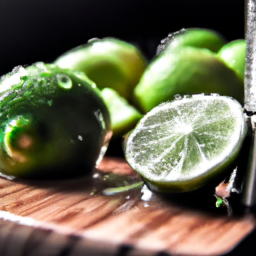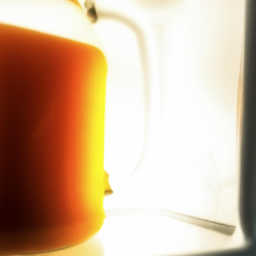Being an enthusiast of everything citrus, I intimately understand the crucial role of lime juice in both culinary and cocktail creations. However, have you ever pondered over the actual amount of juice one can extract from a lime?
In this article, I will explore the science behind lime juice extraction, the various methods used to extract juice from limes, and share some tips on how to get the most juice out of your limes.
When it comes to cooking and mixing drinks, getting the right amount of lime juice can make or break a recipe. But the process of extracting juice from a lime can be tricky and not always straightforward. By understanding the factors that affect lime juice extraction and different methods that can be used, you can ensure that you are getting the most out of your limes and maximizing their potential in your culinary creations.
So let’s dive in and explore the fascinating world of lime juice extraction!
Key Takeaways
- Lime ripeness, temperature, pressure, and acidity levels all affect the amount of juice extracted.
- Different methods of lime juice extraction include hand squeezing, manual juicers, and electric juicers.
- Tips for maximizing lime juice extraction include rolling the lime on a hard surface, using a citrus squeezer, or microwaving the lime for a few seconds.
- Lime juice can substitute for vinegar in recipes that require a tangy flavor and can be used in marinades, sauces, dressings, baking, and cocktails.
Understanding Lime Juice Extraction
Extracting lime juice can be a bit tricky, so it’s important to understand the best techniques for getting the most juice out of each lime. Lime juice has numerous benefits, such as aiding digestion, boosting immunity, and promoting healthy skin and hair. It’s also a great substitute for vinegar in recipes that require a tangy flavor.
To extract lime juice, start by rolling the lime on a hard surface to loosen the juice cells. Cut the lime in half and use a citrus juicer or a fork to extract the juice. Alternatively, you can use a hand-held juicer or squeeze the lime by hand. However, keep in mind that hand squeezing may not yield as much juice as using a juicer.
Overall, the key to extracting the most juice from a lime is to use a method that works best for you and to choose ripe limes that are heavy for their size.
Factors that affect lime juice extraction include the ripeness and temperature of the lime, the method of extraction, and the type of juicer used. By understanding these factors, you can ensure that you are getting the most juice out of each lime and maximizing its benefits in your recipes.
Factors that Affect Lime Juice Extraction
When you squeeze the tangy fruit, the liquid pours out like a burst of sunshine, filling your glass with a refreshing elixir that invigorates your senses. But have you ever wondered why sometimes you get more juice than others?
Here are four factors that can affect lime juice extraction:
-
Lime ripeness: The riper the lime, the juicier it will be. This is because the cells in the fruit break down as it ripens, making it easier to extract juice.
-
Temperature: Warmer limes will yield more juice than colder ones. This is because heat causes the cell membranes to break down, releasing more juice.
-
Pressure: Applying more pressure when squeezing the lime will result in more juice. However, be careful not to apply too much pressure, as this can also extract bitter flavors and oils from the lime peel.
-
Lime juice acidity levels: The pH level of lime juice can affect how much juice is extracted. The closer the pH level is to neutral (7), the more juice can be extracted.
Understanding these factors can help you maximize your lime juice extraction techniques. In the subsequent section about different methods of lime juice extraction, we’ll explore how to use these factors to your advantage.
Different Methods of Lime Juice Extraction
When it comes to extracting lime juice, there are various methods to choose from. As someone who enjoys experimenting with different techniques, I’ve found that hand squeezing is the most straightforward and traditional method.
For those who prefer a more efficient approach, manual and electric juicers are also available options.
Hand Squeezing
You can easily get more juice out of your lime by giving it a good squeeze with your hands. This method is simple and requires no additional tools, making it a popular choice for those who want to quickly extract juice from a lime. However, it may not be the most efficient method for extracting large amounts of juice.
To compare the benefits and alternatives of hand squeezing with other methods, I have created a table below:
| Method | Benefits | Alternatives |
|---|---|---|
| Hand Squeezing | Simple, no additional tools needed | Not efficient for large amounts of juice |
| Manual Juicers | Efficient for large amounts of juice | Requires additional tool, may be more time-consuming |
| Electric Juicers | Very efficient for large amounts of juice | Expensive, may require more cleaning |
As you can see, hand squeezing is a simple and convenient method for extracting lime juice, but it may not be the best choice if you need to extract a large amount of juice. In the next section, I will discuss manual juicers as an alternative method for lime juice extraction.
Manual Juicers
Now, let’s talk about how you can easily get more bang for your buck with a manual juicer. It’s a real game changer in the kitchen. If you’re looking for a way to get the most juice out of your limes, a manual juicer is the perfect tool for the job. Here are four reasons why:
-
High Juice Quality: With a manual juicer, you can get the highest quality juice possible. This is because the juice is extracted slowly and gently, without exposing it to heat or air that can degrade the quality of the juice.
-
Minimal Hand Fatigue: Unlike hand squeezing, which can quickly tire your hands and lead to uneven extraction, a manual juicer allows you to extract juice with minimal fatigue. This means you can get the most juice possible without sacrificing quality or flavor.
-
Easy to Use: Manual juicers are incredibly easy to use. Simply cut your lime in half, place it in the juicer, and press down on the handle to extract the juice. It’s that simple.
-
Easy to Clean: Manual juicers are also incredibly easy to clean. Most models can be disassembled for easy cleaning, and they’re often dishwasher safe.
Using a manual juicer is a great way to get the most juice out of your limes without sacrificing quality or flavor. However, if you’re looking for a faster and more efficient way to juice your limes, an electric juicer may be the way to go.
Electric Juicers
Electric juicers are a game-changer for those who want to save time and effort in the kitchen, making juicing a breeze and leaving you with more time to enjoy your freshly squeezed creations.
When it comes to juicing limes, electric juicers are more efficient compared to manual ones. With an electric juicer, you can juice a large quantity of limes quickly and with minimal effort. This is especially useful when you need to juice a lot of limes for a recipe or when entertaining guests.
Electric juicers are also more precise than manual juicers. They can extract the maximum amount of juice from each lime, leaving behind only the pulp and skin. This means that you get more juice per lime, which can ultimately save you money in the long run.
Overall, an electric juicer is a valuable investment for any kitchen, especially if you frequently use citrus fruits like limes in your cooking and baking.
To get the most juice out of your limes, there are a few tips and tricks to keep in mind.
Tips for Getting the Most Juice Out of Your Limes
When it comes to getting the most juice out of your limes, every drop counts, so make sure to squeeze them until they’re as dry as a bone.
One tip is to roll the lime on a hard surface before cutting it in half. This helps to break down the fibers and release more juice.
You can also try microwaving the lime for a few seconds to soften it up before juicing.
Getting the most juice out of your lime not only helps with creative recipes, but also provides various health benefits.
Lime juice is a good source of vitamin C, which helps to boost the immune system and promote healthy skin. It also contains antioxidants and anti-inflammatory properties that can help reduce the risk of chronic diseases.
So, don’t let any drop go to waste and make sure to get the most out of your lime.
When it comes to lime juice, how much do you actually need?
How Much Lime Juice Do You Need?
Determining the appropriate amount of lime juice can greatly impact the flavor and nutritional benefits of your dish. Lime juice isn’t just a great source of vitamin C; it also contains other important nutrients, such as potassium and folate. These nutrients help support a healthy immune system, improve digestion, and regulate blood pressure. Additionally, lime juice has been shown to have antibacterial and anti-inflammatory properties, making it a valuable addition to any diet.
When it comes to using lime juice in cooking, the amount needed can vary depending on the recipe and personal taste preferences. However, a general rule of thumb is to start with a small amount and add more as needed. It’s also important to note that lime juice can be quite acidic, so adding too much can overpower the other flavors in the dish.
By being mindful of the benefits of lime juice and using it in moderation, you can enhance the nutritional value and taste of your meals.
Moving onto the next section, it’s important to avoid common mistakes that can affect the quality of your lime juice.
Common Mistakes to Avoid
To ensure your lime-infused dishes truly pack a punch, you need to steer clear of some common pitfalls. Just like a ship avoiding rocky shores, you need to navigate away from these mistakes to make sure your lime juice adds the perfect zing to your meals.
Mistakes to avoid when juicing limes include using a dull or serrated knife, failing to roll the lime before juicing it, leaving the lime at room temperature for too long, or using the wrong type of juicer. Using a dull knife can lead to uneven cuts, which can make it difficult to squeeze out all the juice. Serrated knives can damage the lime’s skin, leading to bitter-tasting juice.
Tips for maximizing lime juice extraction include rolling the lime on a hard surface to break down the membranes inside the fruit, using a citrus squeezer to extract as much juice as possible, or microwaving the lime for a few seconds to soften it up. It’s also important to remember to use fresh limes whenever possible, as older limes can be less juicy.
By avoiding these common mistakes and following these tips, you can ensure that your lime juice is fresh, zesty and delicious. Speaking of freshness, let’s now move on to the next section about storing lime juice.
Storing Lime Juice
When it comes to storing lime juice, there are a few key considerations to keep in mind.
Firstly, it’s important to refrigerate lime juice to ensure that it stays fresh and safe to consume.
Secondly, freezing lime juice is also an option, but it may affect the flavor and texture of the juice.
Lastly, it’s important to store lime juice in an airtight container to prevent oxidation and maintain its quality.
Refrigeration
If you want your limes to stay fresh and juicy, you should store them in the refrigerator. Refrigeration helps to extend the shelf life of limes, preventing them from drying out and losing their flavor. When stored in the fridge, limes can last for up to 4 weeks, depending on their ripeness and quality.
To ensure that your limes stay fresh for as long as possible, it is important to store them properly. One way to do this is by placing them in a plastic bag or container before putting them in the fridge. This helps to prevent moisture loss and protects the limes from absorbing any odors from other foods in the fridge. Additionally, it is important to keep the limes away from any direct sunlight or heat sources, as this can accelerate the deterioration process. By taking these simple steps, you can enjoy fresh, juicy limes for an extended period of time.
Now let’s move on to the next section about freezing lime juice.
Freezing
Freezing lime juice can be beneficial in many ways. Firstly, it can prolong the shelf life of the juice and preserve its tangy flavor and acidity for later use. This is especially useful when you have a surplus of limes or are running short on time but need a quick burst of citrusy goodness.
Additionally, freezing lime juice can be a great way to save money and reduce waste, as you can freeze the excess juice instead of letting it go bad and having to throw it away.
When it comes to freezing lime juice, it’s important to use the right containers to ensure that the juice stays fresh and doesn’t develop any unwanted flavors or odors. Plastic containers or freezer bags are good options as they are airtight and can be easily labeled. Glass containers can also be used, but make sure they are designed for freezing and can withstand extreme temperatures.
It’s also important to leave some headspace in the container or bag to allow for expansion as the juice freezes.
To use frozen lime juice in cooking, simply thaw it in the refrigerator or at room temperature and use it as you would fresh juice. Whether you’re making marinades, dressings, or cocktails, having frozen lime juice on hand can be a convenient and cost-effective way to add a burst of citrusy flavor to your dishes.
Using Lime Juice in Cooking
When I use lime juice in cooking, I find it particularly useful for marinades, sauces, and dressings. Lime juice adds a tangy and refreshing flavor that pairs well with many dishes.
In addition, lime juice can also be used in baking to add a subtle citrus flavor to cakes and other baked goods.
Marinades
To make a delicious marinade, you’ll need to squeeze fresh lime juice into the mixture. Lime juice is a versatile ingredient that can add a tangy and citrusy taste to any marinade. Along with lime juice, other common marinade ingredients include olive oil, garlic, herbs, and spices. The flavor combinations are endless, and you can experiment with different ingredients to find the perfect marinade for your dish.
When making a marinade with lime juice, it’s important to balance the acidity of the lime with other ingredients. Too much lime juice can overpower the flavor of the other ingredients, so it’s best to start with a small amount and add more as needed. You can also add sweetness to your marinade with honey or brown sugar.
Once your marinade is ready, simply add your protein and let it marinate for a few hours before cooking.
Transitioning into the subsequent section about ‘sauces and dressings’, it’s important to note that many of the same ingredients used in marinades can also be used in sauces and dressings. The key difference is the consistency of the mixture.
While marinades are usually a liquid mixture used to flavor meat or vegetables before cooking, sauces and dressings can be thicker and used to top salads or other dishes.
Sauces and Dressings
Sauces and dressings are the perfect way to elevate any dish and add a burst of flavor, making them the cherry on top of a delicious meal.
For example, salad dressings can be made with lime juice to add a tangy and refreshing taste to any salad. Lime juice is also a great addition to hot sauces, providing a citrusy kick to balance out the heat.
When making salad dressings, it’s important to use the right amount of lime juice to achieve the desired flavor. Generally, a ratio of 1 part lime juice to 3 parts oil is a good starting point for a vinaigrette. However, the amount of lime juice can vary depending on the other ingredients used.
Similarly, when making hot sauces, the amount of lime juice can affect the overall flavor and level of spiciness. It’s all about finding the right balance to create a delicious and well-rounded sauce.
Moving on to the next topic of baking, let’s explore how lime can be incorporated into sweet treats.
Baking
Incorporating citrus into baked goods can impart a subtle tang and enhance the overall flavor profile of desserts. When it comes to baking with lime juice, here are some tips to keep in mind:
-
Be mindful of the acidity level – too much lime juice can cause the batter to curdle or the dessert to become overly tart.
-
Lime pairs well with tropical flavors like coconut and mango, as well as with spicy ingredients like ginger and chili.
-
Use lime zest in addition to juice to add a bright, citrusy aroma to your baked goods.
-
Experiment with different forms of lime – fresh juice, bottled juice, or even lime oil – to find the best option for your recipe.
When using lime juice in baking, it’s important to balance the acidity level and pair it with complementary flavors for a harmonious dessert.
Now, let’s explore how lime juice can be used in a different context – in cocktails.
Using Lime Juice in Cocktails
You can’t resist the zesty kick that lime juice adds to your favorite cocktail, whether it’s a classic margarita or a refreshing mojito. As a bartender, I’ve experimented with various lime juice brands and found that the best ones are those that are freshly squeezed or bottled with no additives.
Some of my favorite brands include Nellie & Joe’s, ReaLime, and Santa Cruz Organic. However, if you don’t have access to fresh lime juice or prefer not to use bottled lime juice, there are substitutes that can work just as well in cocktails.
Lemon juice is a popular substitute that can be used in equal amounts, but keep in mind that it will alter the flavor of the cocktail. Another option is to use lime cordial or simple syrup made with lime juice, which will add sweetness along with the lime flavor.
Whatever option you choose, make sure to measure carefully and adjust to taste.
Frequently Asked Questions
What are the nutritional benefits of lime juice?
Lime juice benefits include high levels of vitamin C, antioxidants, and flavonoids. It can aid digestion, improve skin health, and boost the immune system. Lime juice recipes are versatile and can be used in drinks, dressings, and marinades.
Can lime juice be used as a natural cleaning agent?
Lime juice can be used as a natural cleaning agent due to its acidic properties. It can effectively remove stains and grease from various surfaces. Additionally, DIY lime juice beauty treatments are popular for their skin brightening and exfoliating effects.
How long do limes typically last before they go bad?
Limes typically last for two to four weeks when stored at room temperature. For longer shelf life, refrigerate them in a plastic bag. Avoid storing them near ethylene-producing fruits like apples and bananas.
Is lime juice safe for individuals with acid reflux or other digestive issues?
Individuals with acid reflux or other digestive issues may want to avoid lime juice due to its high acidity. Lime juice alternatives and heartburn remedies include low-acid citrus fruits, herbal teas, and antacids.
How does the acidity level of lime juice compare to other citrus juices?
Citrus juices vary in acidity levels, with lime juice being more acidic than lemon or orange juice. Despite this, lime juice has numerous benefits, including high levels of antioxidants. Its acidity can be balanced by dilution or mixing with other ingredients.
Conclusion
In conclusion, understanding the process of lime juice extraction is essential for getting the most out of your limes. By considering the different factors that affect extraction and utilizing the various methods available, you can ensure that you’re getting the maximum amount of juice possible.
Remember to avoid common mistakes and store your lime juice properly for optimal taste and freshness. Whether you’re using lime juice in cooking or cocktails, its unique flavor and acidity can add a refreshing and zesty touch to any dish or beverage.
Extracting lime juice can be compared to mining for gold – it takes patience, precision, and a bit of effort, but the end result is worth it. So, the next time you’re squeezing a lime, remember to take your time and use the best techniques available to get the most juice out of your fruit.
With a little practice, you’ll soon become a master at lime juice extraction and be able to enjoy the full range of flavors that this versatile citrus fruit has to offer.
Ilana has been a vegan for over 10 years. She originally made the switch for health reasons, but soon found herself becoming more and more passionate about the ethical and environmental implications of a vegan lifestyle. Ilana is the author of The Graceful Kitchen, a blog all about veganism. She loves to cook up delicious and nutritious vegan meals, and share her recipes with others who are interested in leading a cruelty-free life. Ilana is also a strong advocate for using whole foods as the foundation of a healthy diet, and believes that going vegan is one of the best ways to achieve this.










